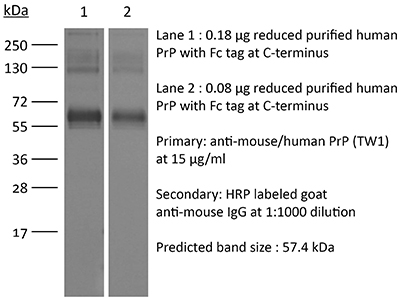InVivoMAb anti-mouse/human PrP (prion protein)
| Clone | TW1 | ||||||||||||
|---|---|---|---|---|---|---|---|---|---|---|---|---|---|
| Catalog # | BE0350 | ||||||||||||
| Category | InVivoMab Antibodies | ||||||||||||
| Price |
|
The TW1 monoclonal antibody reacts with mouse and human prion protein (PrP), also known as PRNP. Specifically, the antibody has been shown to react with mouse PrP AA sequences 90-108, 94-123, and 23-231. PrP is ubiquitously expressed in a variety of different organs and tissues with high expression levels in the central and peripheral nervous systems. Conversion of the normal cellular prion protein (PrPc) into an abnormal conformation (PrPSc) is the crucial step associated with triggering the pathogenesis of prion neurodegenerative disorders. The TW1 antibody has been reported to bind to both PrPc and PrPSc and to block the interaction of PrP with tau protein. In a mouse model of Alzheimer’s disease (AD) the TW1 antibody was shown to effectively ameliorate tau-related pathology.
| Isotype | Mouse IgG2a |
| Recommended Isotype Control(s) | InVivoMAb mouse IgG2a isotype control, unknown specificity |
| Recommended Dilution Buffer | InVivoPure™ pH 7.0 Dilution Buffer |
| Immunogen | Non-denatured PK-resistant fragment of PrPSc purified from brains of CD-1 mice infected with mouse-adapted scrapie strain 139A |
| Reported Applications |
|
| Formulation |
|
| Endotoxin |
|
| Purity |
|
| Sterility | 0.2 μM filtered |
| Production | Purified from tissue culture supernatant in an animal free facility |
| Purification | Protein G |
| Molecular Weight | 150 kDa |
| Storage | The antibody solution should be stored at the stock concentration at 4°C. Do not freeze. |
INVIVOMAB ANTI-MOUSE/HUMAN PRP (PRION PROTEIN)
Boutajangout, A., et al. (2021). “Passive Immunization With a Novel Monoclonal Anti-PrP Antibody TW1 in an Alzheimer’s Mouse Model With Tau Pathology.” Front Aging Neurosci 13: 640677. PubMed
Neurofibrillary tangles (NFTs) are a major pathologic hallmark of Alzheimer’s disease (AD). Several studies have shown that amyloid beta oligomers (Abetao) and tau oligomers mediate their toxicity, in part, via binding to cellular prion protein (PrP(C)) and that some anti-PrP antibodies can block this interaction. We have generated a novel monoclonal anti-PrP antibody (TW1) and assessed the efficacy of passive immunization with it in a mouse model of AD with extensive tau pathology: hTau/PS1 transgenic (Tg) mice. These mice were injected intraperitoneally once a week with TW1 starting at 5 months of age. Behavior was assessed at 8 months of age and brain tissue was subsequently harvested for analysis of treatment efficacy at 9 months. Mice treated with TW1 did not show any significant difference in sensorimotor testing including traverse beam, rotarod, and locomotor activity compared to controls. Significant cognitive benefits were observed with the novel object recognition test (ORT) in the immunized mice (two-tailed, t-test p = 0.0019). Immunized mice also showed cognitive benefits on the closed field symmetrical maze (day 1 two-tailed t-test p = 0.0001; day 2 two-tailed t-test p = 0.0015; day 3 two-tailed t-test p = 0.0002). Reduction of tau pathology was observed with PHF-1 immunohistochemistry in the piriform cortex by 60% (two-tailed t-test p = 0.01) and in the dentate gyrus by 50% (two-tailed t-test p = 0.02) in animals treated with TW1 compared to controls. There were no significant differences in astrogliosis or microgliosis observed between treated and control mice. As assessed by Western blots using PHF-1, the TW1 therapy reduced phosphorylated tau pathology (two-tailed t-test p = 0.03) and improved the ratio of pathological soluble tau to tubulin (PHF1/tubulin; two-tailed t-test p = 0.0006). Reduction of tau pathology also was observed using the CP13 antibody (two-tailed t-test p = 0.0007). These results indicate that passive immunization with the TW1 antibody can significantly decrease tau pathology as assessed by immunohistochemical and biochemical methods, resulting in improved cognitive function in a tau transgenic mouse model of AD.






